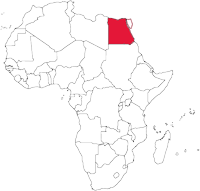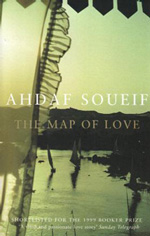
 NOTE: This is an excerpt from a "Trio" which appeared in our sixth issue. You can read the full article here.
NOTE: This is an excerpt from a "Trio" which appeared in our sixth issue. You can read the full article here.
The Map of Love novel was shortlisted for the Booker Prize in 1999, the first nomination for an Arabic writer. Divided into parallel narratives set in 1997 and in the 1900s, The Map of Love recounts the research of present day Isabel into the adventures of her ancestor, Anna. The book is divided into four sections: A Beginning, An End of a Beginning, A Beginning of an End, and An End. To me the book feels like the fairytales my mother read to me before bed, "Once upon a time…."
Isabel Parkman lives in New York, and she is fascinated by Omar, a celebrated Egyptian musician. Isabel travels to Egypt to recover from her failed marriage, keen to attach herself to Omar, with a chest full of papers belonging to her great grandmother Lady Anna Winterbourne. Omar's sister, Amal, narrates Isabel's story, becoming more fascinated as she reads and helps Isabel research Lady Winterbourne's history. And Amal retells Lady Anna Winterbourne's and Sharif Basha al-Baroudi's story, the 'story out of a box'.
Egypt, 1900: Lady Anna Winterbourne arrives to see the Pyramids. Egypt before 1922 was still part of the British Empire, Queen Victoria did not pass away until 1901, and Nationalist Egyptian sentiment was on the rise, which led to constant protests and a popular uprising by 1919. Disaster strikes when Lady Winterbourne is kidnapped whilst riding in the desert. However, Anna is welcomed to the home of her kidnapper Sharif Basha, and even into his harem, eventually becoming his wife.
Ahdaf Soueif has admitted that she wanted The Map of Love to be "Mills and Boon-ish" romance, with a dashing Omar Sharif style hero, and potential lovers on separate sides of the divide so that 'you get a big bang when aggression turns into attraction'. The divide is, of course, that of coloniser and colonised. Through Lady Anna's diary and letters we see her falling in love with Egypt and with the Egyptian people, and coming to understand their political struggle.
Similar in narrative style to Possession by A.S. Byatt, this book is primarily a romance that also succeeds in introducing Egyptian political and historical commentary in an authentic way. Some readers might feel that the 'coincidence' of Isabel and Amal being related is contrived, or that the political discussions within Anna's writing become a list of names, rather than Anna's own opinions about what is happening.
But Soueif casts a spell over the reader, using lyrical language, conjuring romance and mystery alongside every-day life, describing the beautiful landscapes of Egypt and the urban cityscapes of Cairo:
The Map of Love is my favourite book by Ahdaf Soueif; in the form of Anna and Sharif's romance, the novel transports the
reader to another age, makes you fall in love with Egypt, helps you understand the politics with 'a spoonful of sugar' (to help
the political lessons—the medicine—go down). In a recent interview on NDTV's Indian Book Show Ahdaf Soueif identified parallels
between Egyptian society in 1900 and in 1997. She noted that little had changed: in 1882, seven demands were made of the Ottoman
Sultanate by the Egyptians, which ultimately led to the occupation of Egypt by Great Britain for forty years. Today, the same
seven demands are being made of the Egyptian Government.

Bloomsbury Publishing, paperback, 9780747549253